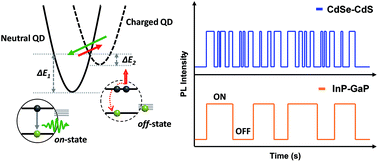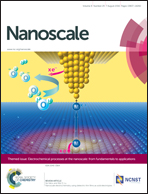Composition-dependent trap distributions in CdSe and InP quantum dots probed using photoluminescence blinking dynamics†
Abstract
Although Group II–VI quantum dots (QDs) have attracted much attention due to their wide range of applications in QD-based devices, the presence of toxic ions in II–VI QDs raises environmental concerns. To fulfill the demands of nontoxic QDs, synthetic routes for III–V QDs have been developed. However, only a few comparative analyses on optical properties of III–V QDs have been performed. In this study, the composition-related energetic trap distributions have been explored by using three different types of core/multishell QDs: CdSe–CdS (CdSe/CdS/ZnS), InP–ZnSe (InP/ZnSe/ZnS), and InP–GaP (InP/GaP/ZnS). It was shown that CdSe–CdS QDs have much larger trap densities than InP–shell QDs at higher energy states (at least 1Eg (band gap energy) above the lowest conduction band edge) based on probability density plots and Auger ionization efficiencies which are determined by analyses of photoluminescence blinking dynamics. This result suggests that the composition of encapsulated QDs is closely associated with the charge trapping processes, and also provides an insight into the development of more environmentally friendly QD-based devices.


 Please wait while we load your content...
Please wait while we load your content...